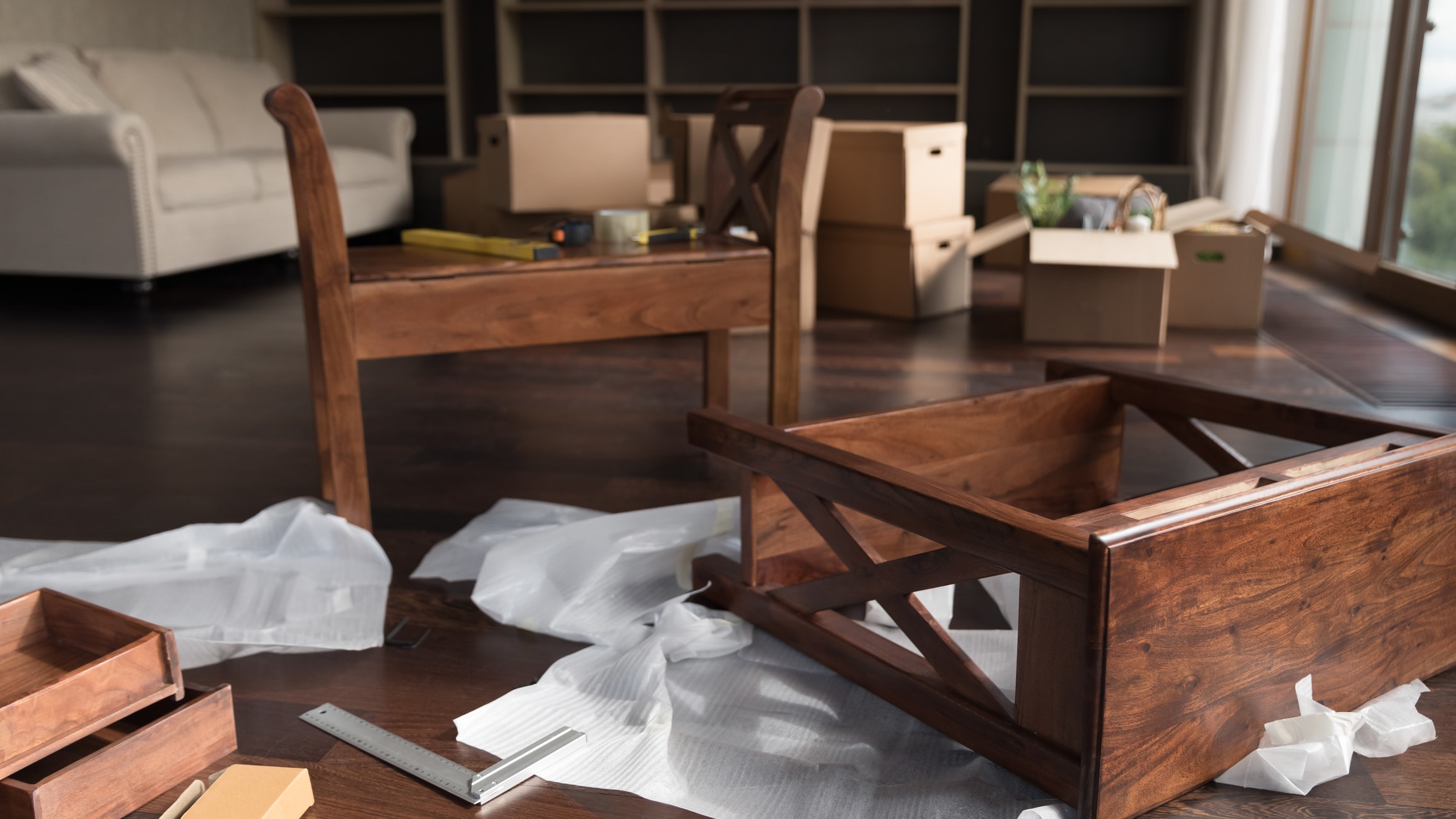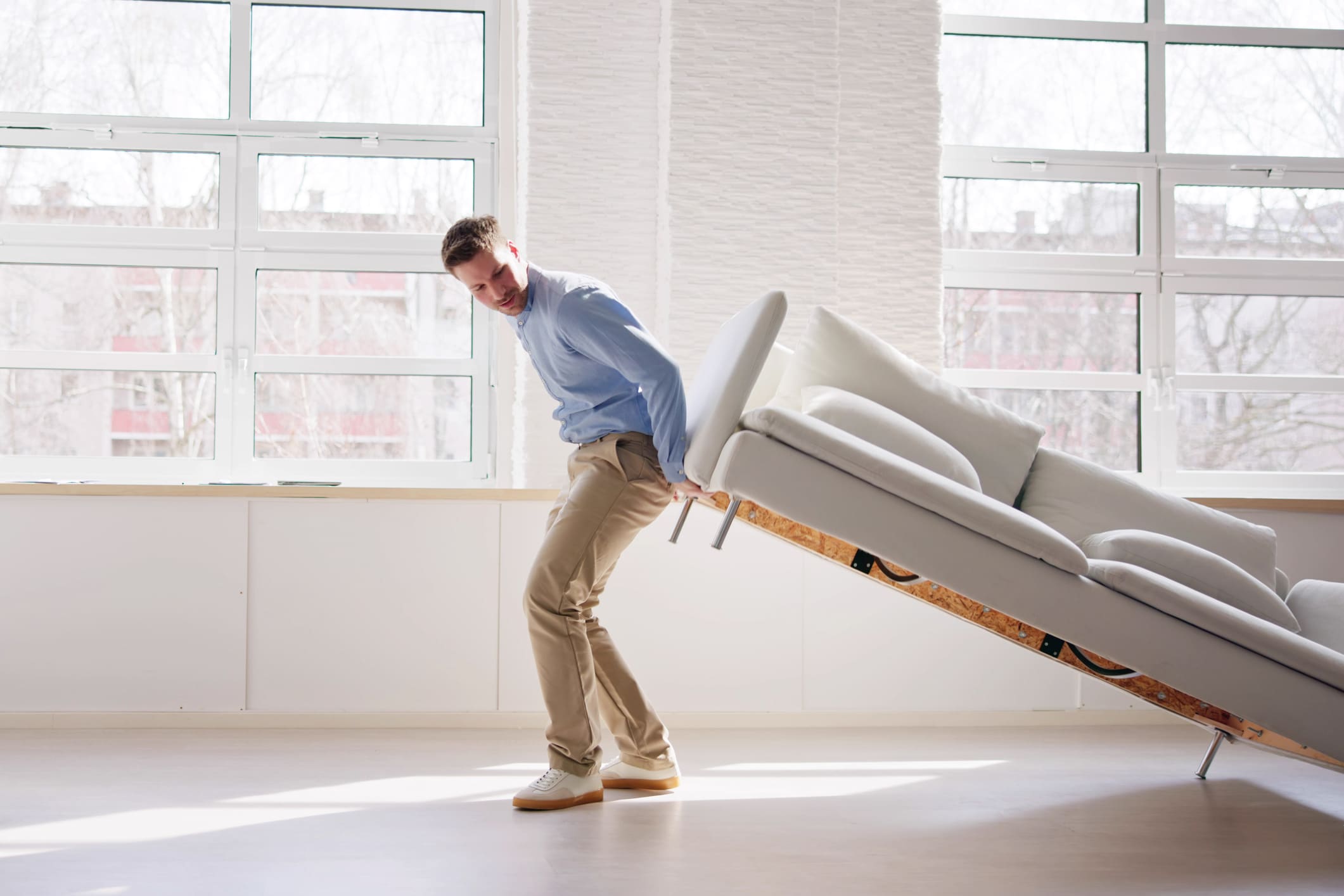Moving heavy furniture isn’t a CrossFit challenge, though it can feel like one if you don’t have a plan.
But you don’t need superhero strength to get that oversized dresser out the door. With the right supplies, a few friends, and a little strategy, moving heavy furniture can actually be safe, manageable, and dare we say … kind of satisfying.
This guide will break down how to move heavy furniture without breaking your back or your stuff. We’ll cover the tools you’ll need, how to protect wooden surfaces, how to move furniture across hardwood floors, and how to get heavy items across carpet. You’ll learn how to lift safely, pivot through tight corners, and secure everything in the truck. (And if you’re eager to learn how to move a piano, these tips will help as well.)
Whether you’re figuring out how to move furniture by yourself, or just want to avoid scraping up your hallway, we’ve got you covered.
Let’s get moving!
How to Move Heavy Furniture Safely
Step 1: Gather Supplies for Moving Heavy Furniture
Before you lift a single couch or cabinet, make sure you’ve got the right gear. Whether you're figuring out how to move heavy furniture on carpet or learning how to protect wooden furniture during a move, grabbing these tools is your first step.
Furniture sliders
These are your best friends when you need to move a sofa without destroying your floor. Sliders reduce friction, making it easier to push heavy pieces across hardwood, tile, or carpet. Use felt sliders for wood and tile, and plastic ones for carpet.
Moving blankets or furniture pads
Don’t do anything without moving blankets or furniture pads. These thick, quilted pads wrap around your wooden furniture to protect it from scratches, chips, and dings.
Stretch wrap (plastic film)
If your furniture has drawers, doors, or detachable cushions, this tool will keep everything in place. Stretch wrap is a clingy plastic film that secures loose parts and prevents them from swinging open or falling off.
Furniture lifting straps
These straps loop under your furniture and over your shoulders to help you lift heavy items using your strongest muscle groups. They take the strain off your back, improve balance, and make it easier to navigate tight corners.
Hand truck or dolly
When you’re staring down a towering bookshelf or loaded file cabinet, grab a dolly. This two-wheeled cart lets you tip and roll bulky items without lifting their full weight. Some come with straps to secure what you’re moving.
Floor runners or protective flooring
Moving furniture across hardwood floors without protection is just asking for scratches. Lay down non-slip floor runners or temporary protective sheets in high-traffic paths.
Corner protectors and foam edge guards
Big pieces and sharp corners are a bad combo in tight spaces. Foam guards and plastic protectors keep the edges of your furniture safe and keep your walls from looking like a bumper car track.
Basic tool kit
Some furniture just isn’t meant to be moved in a single piece. A screwdriver, Allen wrench (aka hex key), or power drill lets you disassemble beds, bookshelves, or dining tables so they’re easier to pack and safer to move.
Packing tape and moving labels
Tape isn’t just for boxes. Use it to hold moving blankets and stretch wrap in place, or to bundle smaller items like furniture legs. Labels help you stay organized when it’s time to reassemble.

Step 2: Make Your Preparations for Moving Heavy Furniture
Supplies are one thing. Strategy is another. Before lifting a single leg off the ground, make a plan. Here’s how to get organized:
1. Make an inventory
Start with a list. Walk room to room and jot down everything you plan to move, from the sectional sofa to the coffee table to the 200-lb armoire you forgot was even that heavy.
This isn’t just a checklist. It helps you determine what packing supplies and tools you’ll need, which pieces need disassembly, and how much help to recruit.
2. Make a path
Furniture doesn’t just teleport. So before you start moving anything, map the route. Measure doorways, hallways, staircases, and anything else your furniture has to pass through. Figure out what’s going where, and in what order.
3. Protect doorways and walls
Big pieces and tight corners don’t mix. To protect your home (and your potential deposit), wrap foam or towels around sharp edges and use corner protectors or cardboard in high-risk areas.
4. Get help if needed
Even with sliders and lifting straps, some pieces are just too bulky or awkward to move solo. If you’re trying to figure out how to move heavy furniture by yourself, remember that sometimes the safest solo move is calling in backup — so consider calling a strong buddy or using professional packing and moving services.
Step 3: Disassemble Oversized Furniture
Some furniture just wasn’t made to fit through doorways in one piece. Here’s how to make your biggest pieces a little more manageable:
How to disassemble furniture for a move:
Take apart bed frames
Start with the mattress and box spring, then move on to the frame. Most standard bed frames can be broken down with a screwdriver or hex key. Check for bolts at the headboard, footboard, and side rails. Keep all hardware in a labeled plastic bag and tape it to the frame so nothing gets lost in the shuffle.
Remove table legs and leaves
Dining tables are deceptively bulky. (They’re more similar to pool tables than you might imagine.) Flip the table on its side and unscrew the legs — there are usually just a few bolts holding them in place.
Break down desks and shelving units
Desks with hutch tops or built-in shelving often come apart more easily than you’d think. Remove drawers, detach the top if possible, and take out any removable shelves. Label the pieces as you go and take pictures along the way to remember how everything fits together.
Take out dresser drawers (when it makes sense)
This one depends on the dresser. If the drawers are heavy and fully loaded, removing them lightens the load and makes it easier to carry. Just make sure to label which drawer goes where, because not all drawers are interchangeable. And don’t forget to remove fragile items before tipping it sideways.
Step 4: Protect Your Furniture
Similar to protecting art for moving, smart packing techniques keep your pieces looking like they did before all the heavy lifting began. Here’s how to pack furniture for moving without regrets:
Wrap it up right
Use moving blankets, stretch wrap, or bubble wrap depending on the type of furniture. Wood furniture should always be covered with breathable materials first (like blankets or furniture pads) then secured with stretch wrap to hold everything in place. Avoid wrapping wood directly in plastic, as it can trap moisture and mess with the finish.
Tape the wrap, not the furniture
This one’s key: always tape moving blankets to themselves, not to your actual furniture. Taping directly to a wood or painted surface is a fast track to a damaged finish or peeled paint. Use packing tape or stretch wrap to secure everything tightly, but keep it off the furniture itself.
Use cardboard as a buffer
Got furniture with glass, sharp edges, or delicate detailing? Cardboard sheets work great as a barrier. Slide a sheet between furniture and wall, or place it over flat surfaces before wrapping.
Protect the corners
Corners take the brunt of most bumps. Use corner protectors (you can buy them or make your own from cardboard and tape) to shield sharp edges and fragile finishes. This is especially important for desks, tables, or antique wood furniture.
Step 5: Move Your Heavy Furniture
There’s a right way to move heavy furniture, and then there’s the way that ends in a strained back, a scuffed floor, or a broken dresser leg (and tears). We’re aiming for the first one.
Here’s how to move furniture without destroying your body, your house, or your sanity.
Lift with your legs, not your ego
Start here: lifting isn’t about brute force, it’s about form. Bend at the knees, keep your back straight, and use your legs to do the work.
Use sliders for smooth moves
If you’re moving heavy furniture on carpet, furniture sliders are your best friend. Tilt the piece slightly and wedge the sliders under each leg or corner. On hardwood, use felt-bottom sliders to avoid scratching the floor.
A spatula or pry bar can help if the furniture’s really low to the ground. Once in place, you can push or pull with way less effort, and way less yelling.
Master the strap game
Moving straps (aka lifting straps or shoulder dollies) help distribute the weight so you don’t overload your back or arms. Loop the straps under the furniture, attach them to your shoulders or forearms, and lift in sync with your partner.
Make a game plan first
Don’t run into a “pivot” situation. Before anyone lifts a thing, talk it out. Who’s leading the way? Where’s the furniture going? Which angle will allow it to pivot through the doorway?
Good communication is what separates a smooth move from a busted hallway mirror. Keep talking the whole time. Stop to adjust your grip. Take breaks. Don’t be a hero.
Turn, don’t force
When maneuvering around corners or through narrow doorways, pivot (correctly) the furniture instead of forcing it straight through. Tilt taller items like dressers or bookshelves to their side and carry them “high-low” — one person holding the top, the other the bottom — for better balance and visibility.
Know when to walk away
Sometimes, the smartest move is to not move it yourself. Oversized sofas, awkward stairwells, or anything that requires tight turns in small spaces might be better left to professional movers. Your back will thank you, and so will your security deposit.

Step 6: Secure Heavy Furniture for the Move
You made it this far without denting a doorframe or throwing out your back, so let’s keep up that energy. Once your furniture is in the truck or container, it must stay put. Shifting mid-drive can lead to broken legs (the furniture’s, not yours), scratched wood, or toppled boxes.
Start with the heavy stuff (but don’t just shove it in)
Load your largest furniture (dressers, bookshelves, couches) first and place them against the walls of the truck or container. Keep the weight distributed evenly on both sides. Too much on one side and you’ll throw off the balance, which can make driving dicey and unloading messier than it needs to be (not to mention, breakage more likely).
Tie it down like you mean it
Use ratchet straps or strong rope to anchor furniture to the hooks or rails along the walls of the truck. Always strap at least two points, top and bottom, on each large piece to prevent tipping or sliding. Secure everything tight enough that nothing shifts, but not so tight that you crack wood or warp frame corners.
Fill in the gaps and cushion like a pro
Once the heavy stuff is locked in, fill the empty spaces with softer items like mattresses, cushions, or tightly packed boxes. These act like buffers and help absorb bumps along the ride.
You can also slide moving blankets between furniture pieces to keep them from knocking into each other, and to protect wooden furniture from scratches or dents.
How to Move Heavy Furniture Safely (Or When to Leave It to the Pros)
With the right supplies, smart planning, and a bit of muscle, it’s totally possible to move heavy furniture by yourself. But let’s be real: even with all the prep in the world, things can still go sideways, literally and figuratively. You may be left with scratched hardwood, a strained back, or a couch that just won’t fit through the door. Some jobs are better left to the pros.
If you’re staring down a long-distance move with oversized furniture or specialty items like pianos or pool tables, bring in the experts. Colonial Van Lines has been helping people move heavy furniture safely for over 50 years. We know how to pack it, protect it, and get it to your new home while minimizing stress. Get a free quote today, and let’s make this move a whole lot easier.

